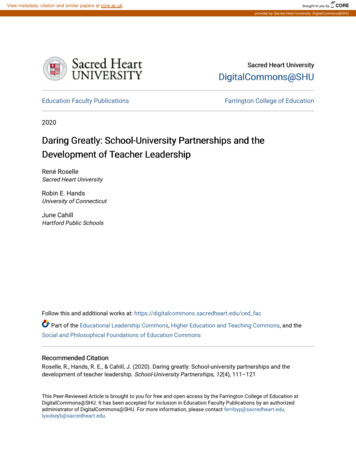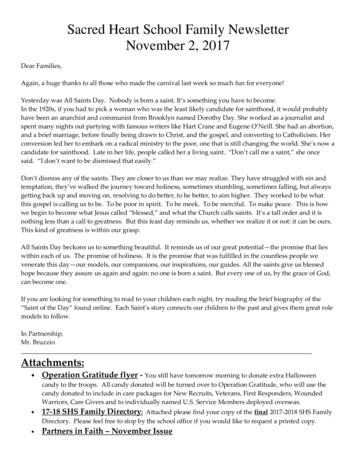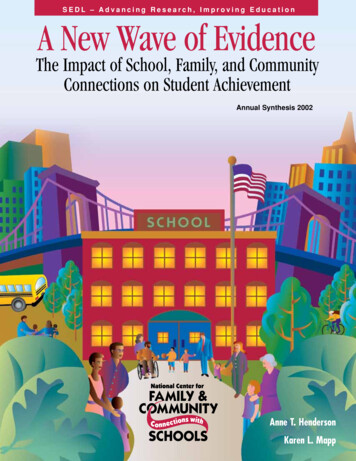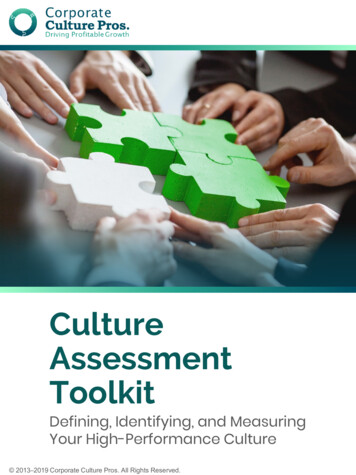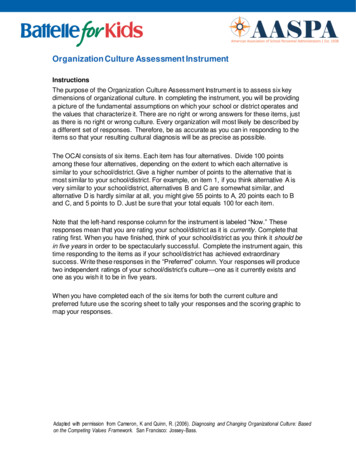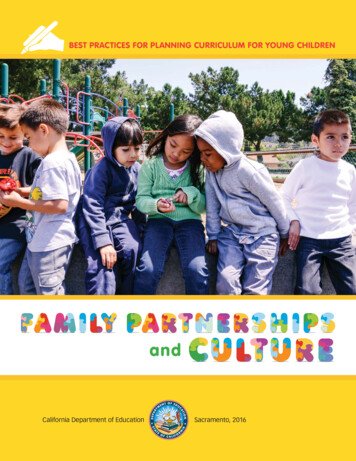
Transcription
BEST PRACTICES FOR PLANNING CURRICULUM FOR YOUNG CHILDRENandCalifornia Department of EducationSacramento, 2016
Publishing InformationFamily Partnerships and Culture was developed by the Early Education and SupportDivision, California Department of Education. This publication was edited by Faye Ong,working in cooperation with Laura Bridges, Child Development Consultant. It wasdesigned and prepared for online posting by the staff of CDE Press, with the coverdesigned by Tuyet Truong. It was published by the Department of Education, 1430 NStreet, Sacramento, CA 95814. It was distributed under the provisions of the LibraryDistribution Act and Government Code Section 11096.ISBN 978-0-8011-1758-9 2016 by the California Department of EducationAll rights reserved.CDE Publications and Educational ResourcesFor information about publications and educational resources available from theCalifornia Department of Education (CDE), visit http://www.cde.ca.gov/re/pn/rc/or call the CDE Press sales office at 1-800-995-4099.Reproduction of this document for resale, in whole or in part, is not authorized.NoticeThe guidance in Family Partnerships and Culture is not binding on local educationalagencies or other entities. Except for the statutes, regulations, and court decisionsthat are referenced herein, the document is exemplary, and compliance with it is notmandatory. (See Education Code Section 33308.5.)
CONTENTSA Message from the State Superintendentof Public Instruction .vAcknowledgments.viForeword.xIntroduction .1Part I. Guiding Principles forDeveloping Cultural Competence .5Cognitive Cultural Competence . 6Affective Cultural Competence . 9Cultural Responsiveness . 10NAEYC Cultural Competence Project .17Part II. Understanding Culture .19Definition of Culture . 20Why an Understanding of Culture Is Important . 22Distinguishing Between Ethnicity and Culture . 25Learning About Cultures . 27Exploring Dimensions of Culture . 30Collectivist Versus Individualist Cultures . 39Myths About Cultures . 42Support Development of the Home Language .47Part III. Understanding Contemporary Familiesand Households .52Family Composition . 55Culturally Based Family Strengths .61Contents iii
Family Strains . 63Impact of Family Stress . 72Part IV. Culture, Family Life, andthe Early Childhood Curricula .75Implications of Cultural and Family Experiences forTeaching and Learning. 78Curriculum Frameworks . 79Conclusion . 95Appendix: Questions to Expand Understanding of Families .99Glossary .106References .108Additional Resources and References . 114iv Family Partnerships and Culture
A Message from the StateSuperintendent of Public InstructionI am pleased to present Family Partnerships and Culture, a publication providing earlychildhood education program administrators and teachers with guidance on practicesthat support the development of partnerships with families and inclusion of children’scultural experiences as essential parts of planning curriculum. Families can be invaluable partners in early childhood programs’ efforts to enhance early learning and prepare children for school. Because the family’s approach to guiding early developmentis influenced by adult family members’ culture or cultures, a key aspect of developingpartnerships with families is to be responsive to their cultures. This publication promotes understanding of children’s cultural or multicultural experiences at home andhelps teachers use those experiences as building blocks for teaching and learning inearly education settings. It complements the resources of the California Departmentof Education’s Early Learning and Development System, particularly the CaliforniaInfant/Toddler Curriculum Framework and the California Preschool Curriculum Framework, Volumes One, Two, and Three.Family Partnerships and Culture draws upon both current research and evidence-basedpractice. This publication offers a comprehensive view of how to include family andculture in curriculum planning. Developing effective partnerships with families involvesbuilding on family and cultural strengths and being supportive of families as they tryto manage stress in their daily lives. The vision of family members, teachers, andprogram directors working together to enhance young children’s learning holds greatpromise. Partnerships that recognize family strengths and create a context forsupporting families will augment other best practices in early education programs.The result is high-quality early learning experiences that contribute to children’swell-being and successful development.Tom TorlaksonState Superintendent of Public InstructionA Message v
AC K N OW L E DGM E N T SThe development of Family Partnerships and Culture involved many people. Thefollowing groups contributed: project leaders, principal writers, additional writers,reviewers, universal design advisers, consultants and reviewers, project staff andadvisers from the WestEd Center for Child and Family Studies, staff from the CaliforniaDepartment of Education (CDE), early childhood education stakeholder organizations,and participants in the formative and review focus groups.1Project LeadersThe following staff members are gratefully acknowledged for their contributions:Peter L. Mangione and Katie Monahan, WestEd.Principal WritersSpecial thanks are extended to the principal writers for their expertise andcontributions.Oscar Barbarin, Tulane UniversityPeter L. Mangione, WestEdAdditional WritersParticular thanks are also extended to the following consultants for their substantivecontributions to the project:Linda Brault, WestEdJanet Gonzalez-Mena, Program for Infant Toddler Care;Napa Valley CollegeGisela Jia, City University of New York, Lehman CollegeAlison Wishard-Guerra, University of California, San DiegoReviewerParticular thanks are extended to the following reviewer for her contributionto the project:Kim Nall, Colusa Indian Community CouncilNote: The names and affiliations of the individuals named were current at the time this publication was developed.vi Family Partnerships and Culture
Universal Design AdvisersThe following universal design experts are gratefully acknowledged for theircontributions:Maurine Ballard-Rosa, California State University, SacramentoLinda Brault, WestEdWestEd Center for Child and Family Studies—Project Staffand AdvisersBrittany AuslanderCharlotte TilsonLinda BraultAnn-Marie WieseMelinda BrookshireMegan WilsonJenae LeahyCaroline Pietrangelo OwensTeresa RagsdaleAmy Schustz-AlvarezCalifornia Department of EducationThanks are extended to the following CDE staff members: Richard Zeiger, Chief DeputySuperintendent of Public Instruction; Lupita Cortez Alcalá, Deputy Superintendent,Instruction and Learning Support Branch; Debra McMannis, Director, Early Educationand Support Division; Cecelia Fisher-Dahms, Administrator, Quality ImprovementOffice, Early Education and Support Division; and Laura Bridges, Child DevelopmentConsultant, Early Education and Support Division, for ongoing revisions and recommendations. During the lengthy development process, many CDE staff members wereinvolved at various levels. Additional thanks are extended to Gail Brodie, Sy DangNguyen, Luis Rios, and Charles Vail, Early Education and Support Division; andMeredith Cathcart, Special Education Division.Early Childhood Education Stakeholder OrganizationsRepresentatives from many statewide organizations provided input that affectedvarious aspects of this publication.Action Alliance for Children (AAC)Alliance for a Better CommunityAsian Pacific Islanders California Action Network (APIsCAN)Association of California School AdministratorsBaccalaureate Pathways in Early Childhood & Education (BPECE)Black Child Development Institute (BCDI), Sacramento AffiliateCalifornia Alliance of African American Educators (CAAAE)California Association for Bilingual Education (CABE)Acknowledgments vii
California Association for the Education of Young Children (CAEYC)California Association for Family Child Care (CAFCC)California Association of Latino Superintendents and Administrators (CALSA)California Child Care Coordinators Association (CCCCA)California Child Care Resource and Referral Network (CCRRN)California Child Development Administrators Association (CCDAA)California Commission on Teacher Credentialing (CCTC)California Community College Early Childhood Educators (CCCECE)California Community Colleges, Chancellor’s Office (CCCCO)California Council for the Social Studies (CCSS)California County Superintendents Educational Services Association (CCSESA)California Early Childhood Mentor ProgramCalifornia Early Reading First NetworkCalifornia Federation of Teachers (CFT)California Head Start Association (CHSA)California Kindergarten Association (CKA)California Preschool Instructional Network (CPIN)California Professors of Early Childhood Special Education (CAPECSE)California School Boards AssociationCalifornia Science Teachers Association (CSTA)California State PTACalifornia State University Office of the ChancellorCalifornia Teachers AssociationCalifornians TogetherCampaign for High Quality Early Learning Standards (CHQELS)Child Development Policy Institute (CDPI)Child Development Training Consortium (CDTC)Children NowThe Children’s CollabriumCouncil for Exceptional Children/California Division for Early Childhood (Cal-DEC)Council of CSU Campus Childcare (CCSUCC)Curriculum Alignment Project (CAP)Curriculum and Instruction Steering Committee (CISC)Desired Results access ProjectDrew Child Development CorporationEnglish Language Learners Preschool Coalition (ELLPC)Federal/State/Tribes Collaboration WorkgroupFight Crime: Invest in Kids CaliforniaFirst 5 Association of Californiaviii Family Partnerships and Culture
First 5 California, California Children & Families CommissionHead Start State-Based Training and Technical Assistance Office for CaliforniaInfant Development Association California (IDA California)Learning Disabilities Association of California (LDCA)Los Angeles Universal Preschool (LAUP)Mexican American Legal Defense and Educational Fund (MALDEF)Migrant Education Even Start (MEES)Migrant Head StartNational Council of La Raza (NCLR)David and Lucile Packard Foundation: Children, Families, and CommunitiesProgramEarly Edge California (formerly Preschool California)Professional Association for Childhood Education (PACE)Special Education Administrators of County Offices (SEACO) committeeSpecial Education Local Plan Area (SELPA) committeeState Advisory Council on Early LearningTeenNOW CaliforniaUniversity of California, Child Care DirectorsUniversity of California, Office of the President (UCOP)Voices for African American Students, Inc. (VAAS)ZERO TO THREEPublic InputTen focus groups, consisting of 115 participants, provided valuable feedback onthe draft publication.PhotographsSpecial thanks are extended to WestEd and the photographers. The following childcare programs and agencies deserve thanks for allowing photographs to be taken ofstaff members, children, and families:Bright Future Early Learning Center, Oakland; Catholic Charities, Treasure IslandChild Development Center, San Francisco; Child Development Center, AmericanRiver College, Los Rios Community College District, Sacramento; El Jardín deLos Niños at University Preparation School at California State University,Channel Islands, Camarillo; Little People of America, Sacramento/San JoaquinValley Chapter; Oakland Headstart, Lion Creek Crossings; Oakland Headstart,West Grand; Roosevelt Infant Center, Los Angeles Unified School District;Shannon Elementary School, West Contra Costa Unified SchoolDistrict; Pinole Thermalito Learning Center Preschool, OrovilleAcknowledgments ix
FOREWORDEven though most families utilize some form of out-of-home care, children under theage of five continue to spend most of their early lives in the family setting. Consequently, families continue to play an especially important role in shaping the course ofchildren’s early development. For this reason, families can be an invaluable partner inachieving early childhood programs’ goal of fostering early skills and preparing childrenfor school. Underscoring this point, the California Infant/Toddler Learning and Development Foundations and the California Preschool Learning Foundations acknowledgeexplicitly the central role of families and culture in children’s readiness for and healthyadaptation to the early childhood setting.Guided by cultural beliefs and principles, families select experiences, convey attitudes,and impart knowledge to their children to prepare them for adulthood. Accordingly,it is important for program staff to learn to collaborate effectively with families. Todevelop a partnership and to tap into the family as a primary resource, teachers andprogram staff must reach out to, learn about, and develop strong partnerships withfamilies. This process requires openness to learning and an effort to understand theindividuality of each family and the diversity of the families from which the childrencome. Culturally competent practices are essential in the early learning setting or environment in order to form authentic partnerships with families that promote children’sdevelopment. Specific knowledge of the child’s cultural or multicultural backgroundand life at home can be thekey to effective teachingand learning. This knowledge is a valuable tool forconnecting what the childalready knows and values tothe new competencies thatprograms seek to nurture. Tothe extent that a program’spolicies and approachesare informed by, reflectiveof, and congruent with thechild’s experiences at home,x Family Partnerships and Culture
children will find it easier to adapt to the requirements of the program and meet theprogram’s expectations for achievement. Deeper knowledge of the children’s familylife will increase the likelihood that teachers will effectively meet children’s needs andserve them successfully.This is a complex yet worthwhile undertaking. Understanding the social conditionsthat children experience at home is complicated by the broad diversity of the childrenattending preschool programs. In many early childhood settings, one finds cubicles inwhich each child stores outdoor clothing and personal objects brought from home.The labels on the children’s cubicles may indicate the ancestry of the family andreflect the culturally and ethnically rich backgrounds of the children, although theremay be exceptions since California is so diverse. Some names may suggest the likelyAnglo-Saxon and Western roots, and others suggest ancestry of Native Americans,African Americans, the original Spanish settlers, or more recent immigrants fromMexico, Latin America, and the Caribbean. Others hint at familial connections to moredistant nations in Eastern Europe, Africa, Asia, and the Middle East. These childrenrepresent the rich array of ethnic and social groups found in many early childhoodprograms. Much of this cultural diversity is due to high levels of immigration. Foreignborn persons represented 12 percent (32.5 million) of the U.S. population in 2002, withalmost 50 percent of that group coming from Latin America, 25 percent from Asia, and20 percent from Europe (Schmidley 2003). In 2010, of the more than 2.5 million childrenunder the age of five living in California, about half of these children were Latino(U.S. Census Bureau 2010). It is important to note that Latinos may be of any race,according to the U.S. Census Bureau. White non-Latino children make up 30 percentof children under five in California, Asian-Pacific Islanders make up 10 percent, AfricanAmericans make up 6 percent, and the remaining 4 percent represent a wide rangeof ethnic groups (Whitebook, Kipnis, and Bellm 2008).Like the children, the program staff members often reflect the different ethnicitieswithin the state, though not in the same proportion as the children. White, non-Latinoeducators make up as much as 53 percent of early childhood teachers; Latinos represent 27 percent of the workforce; African Americans, 7 percent; and Asian-PacificIslanders, 5 percent of the workforce. Members of the early childhood workforcespeak a variety of languages. Although English and Spanish are spoken by the overwhelming majority, other spoken languages include Mandarin, Cantonese, Vietnamese,Korean, Arabic, Russian, and many others (Whitebook, Kipnis, and Bellm 2008). Thisrich diversity of people and the divergent cultures they represent constitute an opportunity and a resource. Human diversity offers exposure to a range of educationalexperiences and worldviews that can broaden the perspectives and enrich the lives ofForeword xi
individuals, particularly those of children. For program staff, this diversity can bea resource that not only enriches, but also brings a set of challenges to grow andexpand intellectual horizons.As noted above, a majority of staff members working in early childhood programs areEuro-American and female, and a majority of the children are Latino. Depending on theteacher’s background, this may mean that a teacher cannot rely solely on his or herpersonal experiences and on common beliefs to understand how children think, perceive, understand, and communicate. Teachers will need to develop a deeper culturalunderstanding if they are to discern why children act as they do.Many teachers, by virtue of their personal backgrounds and training, may not havehad the opportunity to gain the knowledge and experiences that would prepare themfor working with culturally and linguistically diverse children. In light of this possiblelack of knowledge and exposure, working closely with families can offer the opportunity to explore new ideas and approaches that improve the overall operation ofthe program. In turn, this will strengthen staff members’ ability to work well with thechildren they will encounter in classrooms in the twenty-first century. This is especiallyimportant because some children are not flourishing in early childhood programs asmuch as expected. For those children, early difficulties in adjusting to school set themon a track of low academic performance, which may have dire consequences for theirlives as adults. Collaborating with families is an important first step in improving suchoutcomes. Attention to the family’s culture and context increases the likelihood of aneffective partnership with families that can make a world of difference for the child.xii Family Partnerships and Culture
I N T RO DUC T IO NThis publication aims to assist early childhood professionals in the development ofcultural competence in working with children and families from diverse culturalbackgrounds. Specifically, the aims of the publication are to help programs tovalue families and their contribution to children’s learning;approach cultural diversity with an open mind;apply knowledge gained about families, including their valuesand beliefs, to teaching and learning.Efforts to educate and serve children are more effective when collaboration withfamilies is involved. The motivation to involve families often arises from an authenticappreciation of the critical role that families play in children’s learning. Consequently,collaborations between programs and families are more likely to occur when there isan understanding of families’ cultural backgrounds. Deep knowledge of the family andits cultural context can provide teachers with insights about the child’s thinking andbehavior that may be useful in developmental and educational interventions. Moreover, publicly honoring and celebrating the family reinforces a positive identity for thechild and promotes in children the idea that they are valued by staff.Accomplishing these aims requires of staff members both an awareness of thediversity of the people around them and an understanding of self as a cultural being.The dual goals are to increase awareness of the state’s diverse cultures and recognizehow one’s own culture shapes behaviors, attitudes, and responses to those who aredifferent. Specifically, cultural competence includes learning about the family lives ofchildren and developing a deep understanding of the family’s culture. This, in turn,requires insight into the influence of one’s culture in relating to persons who belongto a different cultural group.Attention to Cultural DiversityIt takes an ongoing effort to become sensitive to the differences that are part of thesurrounding world. For teachers, this means becoming aware that the children in theircare come from a variety of cultures. This awareness must go beyond superficialstereotypes. Teachers must be aware of the ethnicity and national heritage of the chilIntroduction 1
dren they serve: the families’ histories, the families’ countries of origin, how long theyhave been here, and what they went through to settle into a new country. Teachersshould learn about the languages spoken by the family members in the child’s home;how long the family has been in the community; the states or regions from whichthey came; whether they are newcomers to the United States, long-time immigrants,or second/third generation. This historical and background information can shed lighton the families’ context, attitudes, and values. This information can also shed light onsimilarities and historical conflicts among groups that are important to know. Whenconfronted with this diversity, program staff must counter the human tendency to regard favorably those who share the same cultural attitudes and whose behavior alignswith one’s cultural standards and, conversely, to view disapprovingly the conduct ofgroups with beliefs, values, and behavioral standards that differ from one’s own.Cultural Self-ReflectionThe process of cultural self-reflection involves knowing one’s identity and the culturalcommunity where one developed and learned as a child. It likewise involves awareness of one’s own cultural background, including examining how personal principlesand beliefs may influence one’s approach to working with children and their families.For example, staff members should identify and reflect deeply on their own culturebased assumptions about important aspects of life, such as morality, nutrition,gender roles, child care, parent–child relations, appropriate displays of emotion,intimacy, family loyalty, and discipline.Individual beliefs and values come frommany sources, the most influential ofwhich is the family. Assumptions formedover a lifetime and passed down over thegenerations shape individual views of theworld and the judgments staff membersmake about what is right or wrong,appropriate or inappropriate, and desirable or undesirable. These views are sodeeply ingrained that they are taken forgranted and can easily be perceived asbeing universal and absolutely true.The goal of cultural learning is to counterthe human tendency to make assumptions about people who are different from2 Family Partnerships and Culture
oneself. It should also open one to the possibility that beliefs different from one’s owncan offer legitimate ways to view and deal with life. When staff members identify theirown cultural assumptions or faulty misconceptions, they may be less likely to criticizeor devalue the practices of others. When early childhood educators examine the subjective and personal basis of their views of life and their practices, as this publicationencourages, they will likely find it possible to broaden their worldview by approachingothers with an open mind.Finally, moving from reflection to action is important. This publication is a guide forprogram staff members as they work through the process of learning about self andabout the families of the children they serve. This guidance provides a foundation forthe work that has to be done, but mastery of the ideas contained here is not enough.Personal reflection on one’s own culture and learning about other cultures asdiscussed herein are the first steps on the path toward effective engagement withdiverse children and families. To be effective, program staff members must movealong the continuum from theory to practice, from intellectual understanding toattitudinal shifts and behavioral change.Understanding of family and culture does not come quickly, nor can it be gleaned froma single source. It involves dual processes: paying attention to the diversity of peoplearound oneself and to self-reflection on one’s own culture and family experiences.Applying knowledge to practice is difficult and defies simple formulae, prescriptions,or scripts. Increasing cultural awareness amounts to little without efforts to applythe knowledge gained toward making program policies and practices more culturallyresponsive. Indeed, this is the most important and, often, the most challenging step.It involves moving from a theoretical appreciation of cultural and familial differencesto building relationships and implementing concrete practices that make the programmore compatible with and responsive to the families served. It means that programstaff members must approach families and establish meaningful relationships withthem. To do this well, staff members must develop an inclusive perspective, devisethoughtful strategies, and sustain implementation of those strategies over time.Mastering this process involves building on cultural competence that includes authentic understanding and acceptance. It should also include cultural responsivenesscharacterized by action and application of the theory to program practices and policiesand to interactions with families. Such a proactive stance is consistent with theuniversal design approach to pursue different pathways to make learning relevantto the diverse population of California’s children (CDE 2011, 5). This process requirespatience and persistence.Introduction 3
Organization of the PublicationThis publication begins with a set of guiding principles for moving from theory to practice, from self-reflection to learning about cultural diversity, and then to apply what islearned to teaching and learning. It moves next to a definition of cultural competenceand proposes a set of principles to guide efforts to develop the knowledge, attitudes,and behaviors associated with cultural competence. These principles are intended tobe a foundation for subsequent discussions of culture, family life, and curriculum.Part II offers an in-depth discussion of culture itself. It defines culture and identifiesthe critical dimensions of culture to which early childhood educators need to attend. Itprovides a rationale for attending to culture and explains how culture is different fromethnicity. Part II then debunks four common myths about culture.The next section concludes by addressing the issue of language diversity and the valueof supporting development of the home language.Part III discusses the dimensions of family life important for child development. Thediscussion includes a description of the strains in contemporary family life and thesources of strength that can be nurtured to promote the well-being of children.Part IV focuses on early childhood curricular domains and how culture and familylife might be reflected in the content or teaching methods used in those domains. Itprovides examples of how notions of family and culture might be incorporated in theimplementation of the curriculum frameworks. In this way, it provides a snapshot ofwhat culturally competent teaching and relations with families looks like and links it tothe curriculum.The publication has been prepared with early childhood program staff as its principalaudience. Examples of strategies for teachers and program staff members are provided throughout to help readers understand how to apply the information. However,administrators, families, family support agencies, and parent advocacy organizationsmay find some of the information useful in performing their roles.Terms in boldface are defined in the glossary at the end of the publication.4 Family Partnerships and Culture
Guiding Principles forDeveloping Cultural CompetenceCultural competence is a multifaceted construct that can havedifferent meanings depending onthe purposes for and the settings inwhich it is used. At its core, culturalcompetence refers to an ability tonegotiate effectively across and torelate
ACKNOWLEDGMENTS The development of Family Partnerships and Culture involved many people. The following groups contributed: project leaders, principal writers, additional writers, reviewers, universal desi


